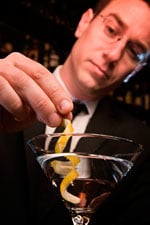 Derek Brown made the switch from sommelier to bartender a few years back, with an approach that blends reverence for the classics with an awareness of service and style. These days, Brown’s work at The Columbia Room — a small bar at the back of the larger The Passenger in Washington, D.C. — means matching food to an individual’s drink profile three nights a week. How? We’ll find out.
Derek Brown made the switch from sommelier to bartender a few years back, with an approach that blends reverence for the classics with an awareness of service and style. These days, Brown’s work at The Columbia Room — a small bar at the back of the larger The Passenger in Washington, D.C. — means matching food to an individual’s drink profile three nights a week. How? We’ll find out.
NCB Mix: You've taken a very particular approach to serving drinks in The Columbia Room, making cocktails a la minute based on your customers' moods and wants — how did that evolve?
Derek Brown: I think of this as the epitome of the bartender's craft. Jerry Thomas said it better than me: "An efficient bartender's first aim should be to please his customers, paying particular attention to meet the individual wishes of those whose tastes and desires he has already watched and ascertained; and, with those whose peculiarities he has had no opportunity of learning, he should politely inquire how they wish their beverages served, and use his best judgment in endeavoring to fulfill their desires to their entire satisfaction."
NCB Mix: How has this idea been received?
Brown: Well, great. I mean, this bar isn't for everyone. But for those who connect with it, it has been an oasis for them — a bar that offers great service and the best cocktails we can make. It's a very sincere effort and also a very intimate space. Therefore, it's very much about the personal interaction. We really get a chance to talk out the drinks and discuss what a person likes and doesn't like. Very often, we can get people to change their mind about a spirit they didn't like before (although that's no entirely our goal).
NCB Mix: What does the success say about the contemporary drinker and the modern bar?
Brown: Contemporary drinkers are looking for ever-increasing personalization in their experience. Another way to say that is, they don't want to feel like they're part of the herd — especially when they're paying upward of $18 a drink in major cities. As an owner and bartender, you have to offer increased personalization while also standing for your vision. It's also about the interaction. Drinkers and foodies have merged closer together and are looking for more than the grocery store approach.
NCB Mix: What does it take specifically for you to get ready for an evening of making cocktails in this manner? Don't you ever wish you were just making Vodka Tonics?
Brown: We carve our own ice, juice our fruit, stock obscure products and generally spend the whole day — sometimes the whole week — getting ready for a night. The point is, we've made a business out of doing what others won't. As a result, we're changing the entire culture (here I mean cocktail bars in general). A Vodka Soda is just plain boring. It's cafeteria food. It's the chicken breast of cocktails. Now, I won't contradict what Thomas wrote: Give the customer what they want. But there's also a legitimate space to see beyond the customer's veneer. They often order a Vodka Soda by default. They either don't know any better, or don't think you do, either. So it's important to be perceptive and recognize what the customer is really asking for and see when an order for a Vodka Soda is really a lifeline.
NCB Mix: What sort of common themes have you found, in your own drink-making ideas and from customers?
Brown: The classics are the classics for a reason. I don't don a fedora and arm garters, but I make classic drinks. I stick with simple combinations and I continually focus on improving my technique. This leads most customers to rediscover drinks they thought they knew: the Manhattan, Martini or Daiquiri. But they are served at differing ratios or with new ingredients. Meanwhile, there are plenty of people trying to push the envelope. I'm trying to invert the trend and have people refocus on technique and simplicity. I love the more ornate, elaborate tendencies but only if they stem from sound principles. I love thinking about [Georges Auguste] Escoffier making good stock or Bernard DeVoto chastising that, "Sound practice begins with ice."
NCB Mix: Is this sort of thing replicable, or does it depend on the bartender, his reputation and the market?
Brown: I think it's the latter. D.C. is a very affluent, well-educated market. These are people who are used to great wine, food and international experiences. It also can't be any old bartender. They have to really care and accept that every day is improvement. It's often those little details that are noticed and commented on. And, lastly, they have to accept that being a bartender is about being a host, not just a mixologist.
NCB Mix: Finally, what's your current favorite cocktail?
Brown: I've really enjoyed the Fourth Regiment Cocktail:
1 ½ ounces rye whiskey
1 ½ ounces sweet vermouth
Dash orange bitters
Dash celery bitters
Dash aromatic bitters
Stir and strain into chilled cocktail glass. Garnish with orange peel.
Learn more at www.passengerdc.com/columbia. Derek also writes about cocktails for The Atlantic and at www.better-drinking.com.
